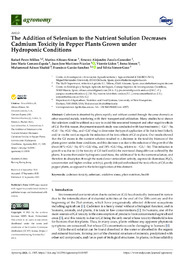Please use this identifier to cite or link to this item:
https://hdl.handle.net/11000/33465Full metadata record
| DC Field | Value | Language |
|---|---|---|
| dc.contributor.author | Perez-Millan, Rafael | - |
| dc.contributor.author | Alfosea Simón, Marina | - |
| dc.contributor.author | Zavala Gonzalez, Ernesto Alejandro | - |
| dc.contributor.author | Cámara-Zapata, José-María | - |
| dc.contributor.author | Martinez Nicolas, Juan Jose | - |
| dc.contributor.author | Lidón Noguera, Vicente | - |
| dc.contributor.author | Simón Vilella, Inmaculada | - |
| dc.contributor.author | Shahid, Muhammad Adnan | - |
| dc.contributor.author | Garcia-Sanchez, Francisco | - |
| dc.contributor.author | Simon Grao, Silvia | - |
| dc.contributor.other | Departamentos de la UMH::Física Aplicada | es_ES |
| dc.date.accessioned | 2024-10-11T11:03:44Z | - |
| dc.date.available | 2024-10-11T11:03:44Z | - |
| dc.date.created | 2021-09-23 | - |
| dc.identifier.citation | Agronomy 2021, 11(10), 1905 | es_ES |
| dc.identifier.issn | 2073-4395 | - |
| dc.identifier.uri | https://hdl.handle.net/11000/33465 | - |
| dc.description.abstract | Cadmium is absorbed by plants rapidly and without control through the same channels as other essential metals, interfering with their transport and utilization. Many studies have shown that selenium could be utilized as a way to avoid this unwanted transport and other negative effects of Cd. For this reason, the present research study was conducted with four treatments (−Cd/−Se, +Cd/−Se, +Cd/+SeF, and +Cd/+SeR) to determine the type of application of Se that is best (foliarly and/or via the root) as regards the reduction of the toxic effects of Cd on plants. Our results showed that the Cd excess in the nutrient solution resulted in a decrease in the total dry biomass of the plants grown under these conditions, and this decrease was due to the reduction of the growth of the shoot (48% +Cd/−Se, 45% +Cd/+SeF, and 38% +Cd/+SeR, relative to −Cd/−Se). This reduction in growth was due to: (i) the toxicity of Cd itself and (ii) the nutritional disequilibrium suffered by the plants. It seems that under hydroponic conditions, the addition of Se to the nutrient solution, and therefore its absorption through the roots (lower antioxidant activity, superoxide dismutase, H2O2 concentration and higher catalase activity), greatly delayed and reduced the toxic effects of Cd on the pepper plants, as opposed to the foliar application of this element. | es_ES |
| dc.format | application/pdf | es_ES |
| dc.format.extent | 16 | es_ES |
| dc.language.iso | eng | es_ES |
| dc.publisher | MDPI | es_ES |
| dc.rights | info:eu-repo/semantics/openAccess | es_ES |
| dc.rights | Attribution-NonCommercial-NoDerivatives 4.0 Internacional | * |
| dc.rights.uri | http://creativecommons.org/licenses/by-nc-nd/4.0/ | * |
| dc.subject | Cadmium toxicity | es_ES |
| dc.subject | Selenium | es_ES |
| dc.subject | Oxidative stress | es_ES |
| dc.subject | Plant nutrition | es_ES |
| dc.subject | Health | es_ES |
| dc.title | The Addition of Selenium to the Nutrient Solution Decreases Cadmium Toxicity in Pepper Plants Grown under Hydroponic Conditions | es_ES |
| dc.type | info:eu-repo/semantics/article | es_ES |
| dc.relation.publisherversion | https://doi.org/10.3390/agronomy11101905 | es_ES |

View/Open:
agronomy-11-01905.pdf
3,42 MB
Adobe PDF
Share:
.png)
